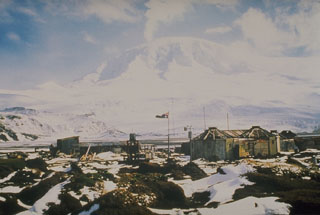Report on Heard (Australia) — April 2019
Bulletin of the Global Volcanism Network, vol. 44, no. 4 (April 2019)
Managing Editor: Edward Venzke.
Research and preparation by Paul Berger.
Heard (Australia) Thermal hotspots continue during October 2018-March 2019 at the summit and on the upper flanks
Please cite this report as:
Global Volcanism Program, 2019. Report on Heard (Australia) (Venzke, E., ed.). Bulletin of the Global Volcanism Network, 44:4. Smithsonian Institution. https://doi.org/10.5479/si.GVP.BGVN201904-234010
Heard
Australia
53.106°S, 73.513°E; summit elev. 2745 m
All times are local (unless otherwise noted)
Heard Island, in the Southern Indian Ocean, includes the large Big Ben stratovolcano and the smaller, apparently inactive, Mt. Dixon. Because of the island's remoteness, satellites are the primary monitoring tool. Big Ben has been active intermittently since 1910, and was active during October 2017-September 2018 (BGVN 43:10). Activity continued during October 2018-March 2019.
Satellite photos using Sentinel Hub showed hotspots every month between October 2018 and March 2019. Because the area was frequently covered by a heavy cloud layer, most of the hotspot signals were partially obscured. Though thermal anomalies are usually seen at summit vents, on 18 October 2018 an anomaly was present about 300 m down the E flank. Similarly, on 1 January 2019, a weak anomaly beginning about 200 m down the NW flank was about 300 m long (figure 40).
The MIROVA (Middle InfraRed Observation of Volcanic Activity) system detected three hotspots, two in October and one in early November 2018, all of low radiative power. There were no MODVOLC alert pixels during this period.
Geological Summary. Heard Island on the Kerguelen Plateau in the southern Indian Ocean consists primarily of the emergent portion of two volcanic structures. The large glacier-covered composite basaltic-to-trachytic cone of Big Ben comprises most of the island, and the smaller Mt. Dixon lies at the NW tip of the island across a narrow isthmus. Little is known about the structure of Big Ben because of its extensive ice cover. The active Mawson Peak forms the island's high point and lies within a 5-6 km wide caldera breached to the SW side of Big Ben. Small satellitic scoria cones are mostly located on the northern coast. Several subglacial eruptions have been reported at this isolated volcano, but observations are infrequent and additional activity may have occurred.
Information Contacts: Sentinel Hub Playground (URL: https://www.sentinel-hub.com/explore/sentinel-playground); Hawai'i Institute of Geophysics and Planetology (HIGP) - MODVOLC Thermal Alerts System, School of Ocean and Earth Science and Technology (SOEST), Univ. of Hawai'i, 2525 Correa Road, Honolulu, HI 96822, USA (URL: http://modis.higp.hawaii.edu/); MIROVA (Middle InfraRed Observation of Volcanic Activity), a collaborative project between the Universities of Turin and Florence (Italy) supported by the Centre for Volcanic Risk of the Italian Civil Protection Department (URL: http://www.mirovaweb.it/).


